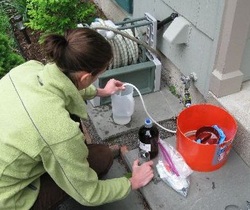Baseline Groundwater Quality Research
 Taking a water sample
Taking a water sample
The potential for extensive natural gas development in New York has ignited concerns regarding possible environmental impacts. While New York is no stranger to natural gas drilling, the potential for the vast development of the Marcellus shale formation combined with the use of hydraulic fracturing technology has led to increased concern about impacts on water quality in particular.
I coordinated a study led by my PhD advisor M.Todd Walter to establish basic baseline water quality levels in central New York, in the event that there is a question of impact on local water resources due to natural gas drilling in the future. In some areas there are existing conventional gas wells and so we all planned to determine if there are any patterns between dissolved methane and distance from existing gas wells, or relationships with any other natural or topographic features. In total, about 140 water samples were taken from drinking water wells in homes across Chenango County and Broome County in central New York, with the help of former undergraduate student Anne Elise Creamer, along with several other short-term volunteers. These samples have been analyzed for dissolved methane gas, as well as total suspended sediment, trace metals and other solutes. Additionally, Caitlin Rose McKinley, an undergraduate student in our group, completed a small study in Tompkins County, NY to look specifically at dissolved methane patterns.
For more information on this project, check out our lab's webpage about it here
A publication featuring findings from the Chenango County groundwater survey is available here, and is open access and accessible to all.
You can also check out a Cornell Chronicle article here that highlights this work.
I coordinated a study led by my PhD advisor M.Todd Walter to establish basic baseline water quality levels in central New York, in the event that there is a question of impact on local water resources due to natural gas drilling in the future. In some areas there are existing conventional gas wells and so we all planned to determine if there are any patterns between dissolved methane and distance from existing gas wells, or relationships with any other natural or topographic features. In total, about 140 water samples were taken from drinking water wells in homes across Chenango County and Broome County in central New York, with the help of former undergraduate student Anne Elise Creamer, along with several other short-term volunteers. These samples have been analyzed for dissolved methane gas, as well as total suspended sediment, trace metals and other solutes. Additionally, Caitlin Rose McKinley, an undergraduate student in our group, completed a small study in Tompkins County, NY to look specifically at dissolved methane patterns.
For more information on this project, check out our lab's webpage about it here
A publication featuring findings from the Chenango County groundwater survey is available here, and is open access and accessible to all.
You can also check out a Cornell Chronicle article here that highlights this work.
